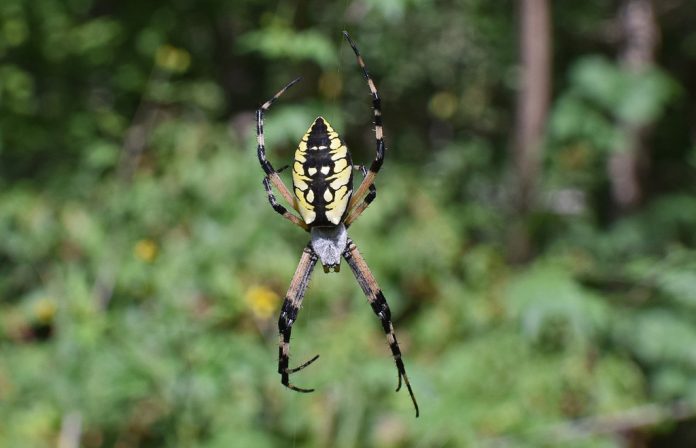Fall is in the air. On Thursday morning the thermometer dipped to 46 degrees. Everywhere I look I see signs of seasonal change.
Leaves have begun to change colors, and some have even begun to fall. Adult male hummingbirds have already headed south.
Blooming goldenrod is turning old fields into oceans of yellow. And orb-weaving spiders are hard to miss in these very same fields.
Orb weavers
My favorite orb-weavers are the striking black-and-yellow garden spiders. They are the large colorful spiders I often encounter while hiking in my hayfield.
Orb weavers begin their sophisticated webs by establishing a bridge from one anchor to another.
From a twig or grass stem, for example, the spider releases a strand of silk from its several pairs of silk-making organs called spinnerets.
The breeze catches the strand and carries it until it touches another perch, and the bridge is formed.
After strengthening the bridge by moving across it several times and laying down more layers of silk, the spider drops from a strand fastened to the center of the bridge. It repeats this process a number of times in all directions until there are a series of spokes radiating outward from the central hub.
Then the spider adds an outward spiral to complete the web.
Spiderweb
Spider silk is strong, elastic, and sticky — perfect for snaring unwitting prey.
Look closely at an orb weaver’s web, and you may find a heavy zig-zag pattern near the center of the web. This distinctive pattern reflects ultraviolet light.
Some spider experts believe this is a lure that attracts unsuspecting insect prey. The rest of the web’s spiral and radiating strands lack this quality.
Prey is attracted to the UV reflection because many pollen and nectar laden flowers also reflect UV light.
Insect pollinators can see UV light and are thus duped into investigating the web’s reflectivity. After they land on the web, it’s too late.
They become entangled on the sticky invisible strands, and the vibrations caused by their thrashing alerts the web weaver that dinner is served.
The spider then dashes out to the victim and subdues it using all of its eight legs (insects have six legs).
It hangs onto the web with its first two pairs of legs, the third pair grabs the prey, and the fourth pair pulls silk from the spinnerets to wrap around the victim.
When the prey is subdued, the spider bites it and injects an immobilizing venom. It then either eats the unfortunate victim or cuts the silken mummy from the web and stores it elsewhere to be eaten later.
Baby spiders
Soon female garden spiders will mate and lay hundreds of eggs in a papery egg sac which is attached to the edge of the web. After laying eggs, females die.
The eggs hatch before winter arrives, but the spiderlings remain in the protective sac until spring.
But not all spiders spin webs to capture prey. In fact, only about 180 of the approximately 4,000 species of spiders that inhabit the U.S. are orb weavers.
Crab spiders
Brightly colored crab spiders, for example, ambush their prey. Their enlarged forward-directed front four legs give them a crab-like appearance, and they hide among colorful flowers and wait for unsuspecting pollinators.
Wolf spiders
Wolf spiders are large, active predators that run down their prey. When not hunting, they rest under rocks or in burrows.
Female wolf spiders carry their egg cases under their abdomen, and when the spiderlings hatch, they gather on their mother’s back.
If startled, the brood can scurry in all directions, giving the impression that a big spider magically transformed into many tiny ones.
Fishing spiders
And fishing spiders rest on bits of floating vegetation and detect vibrations on the water surface when insects fall in. The water serves as a substitute web.
Other times, fishing spiders feed more actively. They may dangle their front legs in the water to lure a nearby aquatic insect or minnow.
For more information about spiders, visit www.spiders.us.













